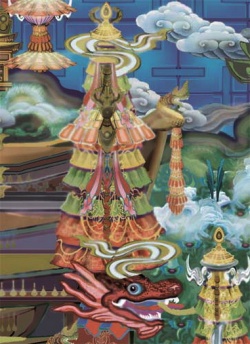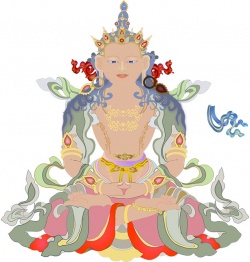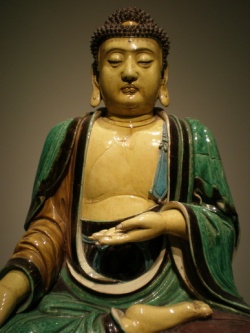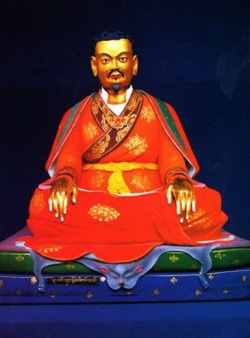Difference between revisions of "Ishtadevata"
| (5 intermediate revisions by the same user not shown) | |||
| Line 1: | Line 1: | ||
| − | {{DisplayImages| | + | {{DisplayImages|587|1935|251|1344|899|865}} |
<poem> | <poem> | ||
| − | In [[Vajrayana Buddhism]], an [[Ishta-deva]] or [[Ishta-devata]] ([[Sanskrit]]: [[इष्टदेवता]]) ([[Yidam]] in [[Tibetan]]) is a [[fully enlightened being]] who is the focus of personal [[meditation]], during a [[retreat]] or for [[life]]. The term is often translated into English as [[ | + | In [[Vajrayana Buddhism]], an [[Ishta-deva]] or [[Ishta-devata]] ([[Sanskrit]]: [[इष्टदेवता]]) ([[Yidam]] in [[Tibetan]]) is a [[fully enlightened being]] who is the focus of personal [[meditation]], during a [[retreat]] or for [[life]]. The term is often translated into English as [[tutelary deity]], [[meditation deity]], or [[meditational deity]]. The [[Ishta-deva]] appears in the '[[Inner refuge]] [[formula]] of the [[Three Roots]] and is also the key [[element]] of [[Deity Yoga]] since the '[[deity]]' in the [[yoga]] is the [[Ishta-deva]]. |
Nomenclature and {{Wiki|etymology}} | Nomenclature and {{Wiki|etymology}} | ||
| − | The [[Sanskrit]] [[word]] [[iṣṭadevatā]] or [[iṣṭadevaḥ]] is a compound of iṣṭa ([[desired]], liked, reverenced) + [[devatā]] (a [[deity]] or [[divine being]]). It is defined by V. S. Apte as "a | + | The [[Sanskrit]] [[word]] [[iṣṭadevatā]] or [[iṣṭadevaḥ]] is a compound of [[iṣṭa]] ([[desired]], liked, reverenced) + [[devatā]] (a [[deity]] or [[divine being]]). It is defined by V. S. Apte as "a [[favorite god]], one's [[tutelary deity]]." Though this term is used in many popular [[books]] on [[Buddhist Tantra]], the term [[işţadevatā]] has not been attested in any [[Buddhist]] [[tantric]] text in [[Sanskrit]]. The [[word]] corresponding to this {{Wiki|concept}} is [[adhideva]], though of rare occurrence. The unrelated [[Tibetan]] version of the term, possibly of entirely native origin, is [[yi-dam]] is said to be a contraction of Tib. [[yid-kyi-dam-tshig]], meaning "[[samaya of mind]]"- in other words, the [[state of being]] indestructibly bonded with the inherently [[pure]] and {{Wiki|liberated}} [[nature of mind]]. |
[[Three Roots]] | [[Three Roots]] | ||
| − | The [[Ishta-deva]] appears as one of the [[Three Roots]] in the [[Tibetan | + | The [[Ishta-deva]] appears as one of the [[Three Roots]] in the [[Tibetan]] [[Buddhist]] '[[Inner refuge]] formulation. The {{Wiki|iconography}} of the [[Ishta-deva]] may be '[[peaceful]]', '[[wrathful]]' ([[Tibetan]] [[tro wa]]) or 'neither [[peaceful]] or [[wrathful]]'([[Tibetan]]: [[shi ma tro]]), depending on the practitioner's own [[nature]]. The [[Ishta-deva]] represents [[awakening]] and so its [[appearance]] reflects whatever is required by the [[practitioner]] in order to [[awaken]]. The [[guru]] will [[guide]] the [[student]] as to which [[Ishta-deva]] is appropriate for them and then [[initiation]] into the [[mandala]] of the [[Ishta-deva]] is given by the [[guru]], so that [[Deity Yoga]] practices can be undertaken. In [[essence]], the [[mindstream]] of the [[guru]] and the [[yidam]] are indivisible. The [[yidam]] is considered to be the [[root]] of [[success]] in the practice. |
[[Ishta-devatas]] in {{Wiki|East Asian}} [[Buddhism]] | [[Ishta-devatas]] in {{Wiki|East Asian}} [[Buddhism]] | ||
| − | The [[Vajrayana traditions]] of [[China]], [[Korea]] and [[Japan]], while smaller and less prominent than Indo-Tibetan [[tantric]] [[Buddhism]], are characterized in part by the utilization of [[isha-devatas]] in [[meditation]]. One prominent [[ishta-devata]] in {{Wiki|East Asian}} [[vajrayana]] is [[Marici]] (Ch: [[Molichitian]], Jp: [[Marishi-ten]]). In the [[Shingon]] [[tradition]] of [[Japan]], prominent [[isha-devatas]] include the "five mysteries of | + | The [[Vajrayana traditions]] of [[China]], [[Korea]] and [[Japan]], while smaller and less prominent than Indo-Tibetan [[tantric]] [[Buddhism]], are characterized in part by the utilization of [[isha-devatas]] in [[meditation]]. One prominent [[ishta-devata]] in {{Wiki|East Asian}} [[vajrayana]] is [[Marici]] (Ch: [[Molichitian]], Jp: [[Marishi-ten]]). In the [[Shingon]] [[tradition]] of [[Japan]], prominent [[isha-devatas]] include the "[[five mysteries of Vajrasattva]]," which are [[Vajrasattva]] (Jp. [[Kongosatta]]), [[Surata]]/[[Ishta-vajrinī]] (Jp. [[Yoku-kongonyo]] "[[慾金剛女]]"), [[Kelikilā-vajrinī]] (Jp. [[Shoku-kongonyo]] "[[触金剛女]]"), [[Kāmā/Rāga-vajrinī]] ((Jp. [[Ai-kongonyo]] "[[愛金剛女]]"), and [[Kāmesvarā]]/[[Mana-vajrinī]] ((Jp. [[Man-kongonyo]] "[[慢金剛女]]"). |
[[Ishta-devatas]] in {{Wiki|Nepalese}} [[Newar Buddhism]] | [[Ishta-devatas]] in {{Wiki|Nepalese}} [[Newar Buddhism]] | ||
| − | The principal [[ishta-devetas]] in the {{Wiki|Newar}} [[Vajrayana tradition]] of [[Nepal]] are [[Chakrasamvara]] and [[Vajravarahi]]. In that [[tradition]], three components are [[essential]] to a [[temple]] complex: a main [[shrine]] [[symbolizing]] [[Svayambhu Mahachaitya]]; an [[exoteric]] [[shrine]] featuring [[Buddha Shakyamuni]] and other [[buddhas]] and [[bodhisattvas]]; and an [[esoteric]] [[shrine]] dedicated to the [[ishta devatas]], to which only initiates may be admitted. | + | The [[principal]] [[ishta-devetas]] in the {{Wiki|Newar}} [[Vajrayana tradition]] of [[Nepal]] are [[Chakrasamvara]] and [[Vajravarahi]]. In that [[tradition]], three components are [[essential]] to a [[temple]] complex: a main [[shrine]] [[symbolizing]] [[Svayambhu Mahachaitya]]; an [[exoteric]] [[shrine]] featuring [[Buddha Shakyamuni]] and other [[buddhas]] and [[bodhisattvas]]; and an [[esoteric]] [[shrine]] dedicated to the [[ishta devatas]], to which only initiates may be admitted. |
| − | Working definition | + | Working [[definition]] |
According to The [[Tonglen]] and [[Mind Training]] Site which discusses [[Tonglen]] and [[Ngöndro]], [[Yidam]] is: | According to The [[Tonglen]] and [[Mind Training]] Site which discusses [[Tonglen]] and [[Ngöndro]], [[Yidam]] is: | ||
| Line 25: | Line 25: | ||
{{Wiki|Exegesis}} | {{Wiki|Exegesis}} | ||
| − | During the ([[meditation]]) practice of the [[generation stage]], a [[practitioner]] ([[sadhaka]]) establishes a strong familiarity with the [[Ishta-deva]] (an [[enlightened being]]) by means of [[visualization]] and a high level of [[concentration]]. During the practice of the [[completion stage]], a [[practitioner]] focusses on methods to actualize the [[transformation]] of ones' own [[mindstream]] and [[body]] into the [[meditation]] [[Deity]] by [[meditation]] and [[yogic]] techniques of energy-control such as [[kundalini]] ([[tummo]] in [[Tibetan]]). Through these complementary [[disciplines]] of generation and completion one increasingly [[perceives]] the pervasive [[Buddha nature]]. | + | During the ([[meditation]]) practice of the [[generation stage]], a [[practitioner]] ([[sadhaka]]) establishes a strong [[familiarity]] with the [[Ishta-deva]] (an [[enlightened being]]) by means of [[visualization]] and a high level of [[concentration]]. During the practice of the [[completion stage]], a [[practitioner]] focusses on methods to actualize the [[transformation]] of ones' own [[mindstream]] and [[body]] into the [[meditation]] [[Deity]] by [[meditation]] and [[yogic]] techniques of energy-control such as [[kundalini]] ([[tummo]] in [[Tibetan]]). Through these complementary [[disciplines]] of [[generation and completion]] one increasingly [[perceives]] the {{Wiki|pervasive}} [[Buddha nature]]. |
[[Judith Simmer-Brown]] summarises: | [[Judith Simmer-Brown]] summarises: | ||
| − | ... a [[yidam]], a personal [[meditational deity]], a potent [[ritual]] [[symbol]] simultaneously representing the [[mind]] of the [[guru]] and [[lineage]] of [[enlightened]] [[teachers]], and the [[enlightened mind]] of the [[tantric]] [[practitioner]]. [[Recognizing]] the inseparability of these two is the ground of [[tantric]] practice.[15] | + | ... a [[yidam]], a personal [[meditational deity]], a potent [[ritual]] [[symbol]] simultaneously representing the [[mind]] of the [[guru]] and [[lineage]] of [[enlightened]] [[teachers]], and the [[enlightened mind]] of the [[tantric]] [[practitioner]]. [[Recognizing]] the {{Wiki|inseparability}} of these two is the ground of [[tantric]] practice.[15] |
[[Berzin]] (1997: unpaginated) in discussing [[Buddhist]] [[refuge]] commitment and [[bodhisattva vows]] frames a caution to [[sadhana]]: | [[Berzin]] (1997: unpaginated) in discussing [[Buddhist]] [[refuge]] commitment and [[bodhisattva vows]] frames a caution to [[sadhana]]: | ||
| − | More specifically, this commitment means not taking [[Wikipedia:Absolute (philosophy)|ultimate]] [[refuge]] in [[gods]] or [[spirits]]. [[Buddhism]], particularly in its [[Tibetan]] [[form]], often contains [[ritual]] {{Wiki|ceremonies}}, or [[pujas]], directed toward various Buddha-figures or fierce [[protectors]] in order to help dispel {{Wiki|obstacles}} and accomplish constructive purposes. Performing these {{Wiki|ceremonies}} provides conducive circumstances for negative potentials to ripen in [[trivial]] rather than major {{Wiki|obstacles}}, and positive potentials to ripen sooner rather than later. If we have built up overwhelmingly negative potentials, however, these {{Wiki|ceremonies}} are ineffective in averting difficulties. Therefore, propitiating [[gods]], [[spirits]], [[protectors]] or even [[Buddhas]] is never a substitute for attending to our [[karma]] – avoiding {{Wiki|destructive}} conduct and acting in a constructive [[manner]]. [[Buddhism]] is not a [[spiritual]] [[path]] of protector-worship, or even Buddha-worship. The safe [[direction]] of the [[Buddhist path]] is working to become a [[Buddha]] ourselves.[16] | + | More specifically, this commitment means not taking [[Wikipedia:Absolute (philosophy)|ultimate]] [[refuge]] in [[gods]] or [[spirits]]. [[Buddhism]], particularly in its [[Tibetan]] [[form]], often contains [[ritual]] {{Wiki|ceremonies}}, or [[pujas]], directed toward various Buddha-figures or fierce [[protectors]] in order to help dispel {{Wiki|obstacles}} and [[accomplish]] constructive purposes. Performing these {{Wiki|ceremonies}} provides conducive circumstances for negative potentials to ripen in [[trivial]] rather than major {{Wiki|obstacles}}, and positive potentials to ripen sooner rather than later. If we have built up overwhelmingly negative potentials, however, these {{Wiki|ceremonies}} are ineffective in averting difficulties. Therefore, propitiating [[gods]], [[spirits]], [[protectors]] or even [[Buddhas]] is never a substitute for attending to our [[karma]] – avoiding {{Wiki|destructive}} conduct and acting in a constructive [[manner]]. [[Buddhism]] is not a [[spiritual]] [[path]] of protector-worship, or even Buddha-worship. The safe [[direction]] of the [[Buddhist path]] is working to become a [[Buddha]] ourselves.[16] |
| − | In the [[Vajrayana]] practices of [[Tibetan Buddhism]], ' | + | In the [[Vajrayana]] practices of [[Tibetan Buddhism]], '[[safe direction]]', or '[[refuge]]' is undertaken through the [[Three Roots]], the [[practitioner]] relying on an [[Ishta-deva]] in [[Deity Yoga]] as a means of becoming a [[Buddha]]. |
Common [[yidams]] | Common [[yidams]] | ||
| − | Some common [[Ishta-devas]] include [[Hayagriva]], [[Vajrakilaya]] ([[Dorje Phurba]]), [[Samputa]], [[Guhyasamaja]], [[Yamantaka]], [[Hevajra]], [[Kurukulle]], [[Cakrasamvara]], [[Vajrayogini]], and [[Kalachakra]]. Also, other [[enlightened beings]] such as the regular [[forms]] of the [[Buddhas]], [[Bodhisattvas]], [[Padmasambhava]], certain [[Dharmapalas]], [[Dakinis]], [[Wealth Deities]], and [[yab-yum]] {{Wiki|representations}}, among others, can also be practiced as an [[ishta-deva]]. [[Avalokiteshvara]], [[Tara]], [[Manjusri]], [[Hevajra]] and [[consort]] [[Nairatmya]], Heruka-Chakrasamvara and [[consort]] [[Vajravarahi]], etc. are frequently chosen as [[Ishta-devas]], but any [[deity]] of the [[tantric]] {{Wiki|pantheon}} may be adopted as such. The [[Ishta-deva]] is used as a means or a goal of [[transformation]] towards full [[enlightenment]]. According to certain [[traditions]], the [[Ishta-devas]] are considered as the [[emanation]] of the adept's own [[mind]]. | + | Some common [[Ishta-devas]] include [[Hayagriva]], [[Vajrakilaya]] ([[Dorje Phurba]]), [[Samputa]], [[Guhyasamaja]], [[Yamantaka]], [[Hevajra]], [[Kurukulle]], [[Cakrasamvara]], [[Vajrayogini]], and [[Kalachakra]]. Also, other [[enlightened beings]] such as the regular [[forms]] of the [[Buddhas]], [[Bodhisattvas]], [[Padmasambhava]], certain [[Dharmapalas]], [[Dakinis]], [[Wealth Deities]], and [[yab-yum]] {{Wiki|representations}}, among others, can also be practiced as an [[ishta-deva]]. [[Avalokiteshvara]], [[Tara]], [[Manjusri]], [[Hevajra]] and [[consort]] [[Nairatmya]], [[Heruka-Chakrasamvara]] and [[consort]] [[Vajravarahi]], etc. are frequently chosen as [[Ishta-devas]], but any [[deity]] of the [[tantric]] {{Wiki|pantheon}} may be adopted as such. The [[Ishta-deva]] is used as a means or a goal of [[transformation]] towards full [[enlightenment]]. According to certain [[traditions]], the [[Ishta-devas]] are considered as the [[emanation]] of the adept's own [[mind]]. |
[[Ishta-devas]] with accoutrements and [[attributes]] | [[Ishta-devas]] with accoutrements and [[attributes]] | ||
| Line 48: | Line 48: | ||
{{Wiki|Color}}: White | {{Wiki|Color}}: White | ||
Enemy: [[Stupidity]] | Enemy: [[Stupidity]] | ||
| − | [[Virtue]]: All-accommodating, [[embodiment | + | [[Virtue]]: All-accommodating, [[embodiment of emptiness]] |
[[East]] | [[East]] | ||
| Line 56: | Line 56: | ||
[[Consort]]: [[Mamaki]] | [[Consort]]: [[Mamaki]] | ||
{{Wiki|Color}}: Blue | {{Wiki|Color}}: Blue | ||
| − | Enemy: Violent [[Anger]] | + | Enemy: [[Violent]], [[Anger]] |
[[Virtue]]: [[Mirror-like Wisdom]] | [[Virtue]]: [[Mirror-like Wisdom]] | ||
Accompanying [[Bodhisattvas]]: [[Kshitigarbha]], [[Lasema]], [[Maitreya]], [[Pushpema]] | Accompanying [[Bodhisattvas]]: [[Kshitigarbha]], [[Lasema]], [[Maitreya]], [[Pushpema]] | ||
| Line 67: | Line 67: | ||
{{Wiki|Color}}: Yellow | {{Wiki|Color}}: Yellow | ||
Enemy: [[Egotism]] | Enemy: [[Egotism]] | ||
| − | [[Virtue]]: Equality | + | [[Virtue]]: [[Equality]] |
Accompanying [[Bodhisattvas]]: [[Akasha]] [[Garbha]], [[Mahlaima]], [[Samantabhadra]], [[Dureme]] | Accompanying [[Bodhisattvas]]: [[Akasha]] [[Garbha]], [[Mahlaima]], [[Samantabhadra]], [[Dureme]] | ||
| Line 88: | Line 88: | ||
{{Wiki|Color}}: Green | {{Wiki|Color}}: Green | ||
Enemy: [[Jealousy]] | Enemy: [[Jealousy]] | ||
| − | [[Virtue]]: All-performing | + | [[Virtue]]: [[All-performing Wisdom]] |
Accompanying [[Bodhisattvas]]: [[Chag-na-Dorje]], Gan | Accompanying [[Bodhisattvas]]: [[Chag-na-Dorje]], Gan | ||
</poem> | </poem> | ||
{{W}} | {{W}} | ||
[[Category:Deities]] | [[Category:Deities]] | ||
Latest revision as of 17:33, 8 April 2014
In Vajrayana Buddhism, an Ishta-deva or Ishta-devata (Sanskrit: इष्टदेवता) (Yidam in Tibetan) is a fully enlightened being who is the focus of personal meditation, during a retreat or for life. The term is often translated into English as tutelary deity, meditation deity, or meditational deity. The Ishta-deva appears in the 'Inner refuge formula of the Three Roots and is also the key element of Deity Yoga since the 'deity' in the yoga is the Ishta-deva.
Nomenclature and etymology
The Sanskrit word iṣṭadevatā or iṣṭadevaḥ is a compound of iṣṭa (desired, liked, reverenced) + devatā (a deity or divine being). It is defined by V. S. Apte as "a favorite god, one's tutelary deity." Though this term is used in many popular books on Buddhist Tantra, the term işţadevatā has not been attested in any Buddhist tantric text in Sanskrit. The word corresponding to this concept is adhideva, though of rare occurrence. The unrelated Tibetan version of the term, possibly of entirely native origin, is yi-dam is said to be a contraction of Tib. yid-kyi-dam-tshig, meaning "samaya of mind"- in other words, the state of being indestructibly bonded with the inherently pure and liberated nature of mind.
Three Roots
The Ishta-deva appears as one of the Three Roots in the Tibetan Buddhist 'Inner refuge formulation. The iconography of the Ishta-deva may be 'peaceful', 'wrathful' (Tibetan tro wa) or 'neither peaceful or wrathful'(Tibetan: shi ma tro), depending on the practitioner's own nature. The Ishta-deva represents awakening and so its appearance reflects whatever is required by the practitioner in order to awaken. The guru will guide the student as to which Ishta-deva is appropriate for them and then initiation into the mandala of the Ishta-deva is given by the guru, so that Deity Yoga practices can be undertaken. In essence, the mindstream of the guru and the yidam are indivisible. The yidam is considered to be the root of success in the practice.
Ishta-devatas in East Asian Buddhism
The Vajrayana traditions of China, Korea and Japan, while smaller and less prominent than Indo-Tibetan tantric Buddhism, are characterized in part by the utilization of isha-devatas in meditation. One prominent ishta-devata in East Asian vajrayana is Marici (Ch: Molichitian, Jp: Marishi-ten). In the Shingon tradition of Japan, prominent isha-devatas include the "five mysteries of Vajrasattva," which are Vajrasattva (Jp. Kongosatta), Surata/Ishta-vajrinī (Jp. Yoku-kongonyo "慾金剛女"), Kelikilā-vajrinī (Jp. Shoku-kongonyo "触金剛女"), Kāmā/Rāga-vajrinī ((Jp. Ai-kongonyo "愛金剛女"), and Kāmesvarā/Mana-vajrinī ((Jp. Man-kongonyo "慢金剛女").
Ishta-devatas in Nepalese Newar Buddhism
The principal ishta-devetas in the Newar Vajrayana tradition of Nepal are Chakrasamvara and Vajravarahi. In that tradition, three components are essential to a temple complex: a main shrine symbolizing Svayambhu Mahachaitya; an exoteric shrine featuring Buddha Shakyamuni and other buddhas and bodhisattvas; and an esoteric shrine dedicated to the ishta devatas, to which only initiates may be admitted.
Working definition
According to The Tonglen and Mind Training Site which discusses Tonglen and Ngöndro, Yidam is:
Visualized representative of your enlightened energy, or Buddha-nature. Tricky concept for Westerners; closest concept might be that of a patron saint in Catholicism, except that a yidam is not a historical figure and is not necessarily supposed to 'exist' in the same way human beings do. Other related concepts might be a totem or power animal in the Native American tradition, or even the fairy godmother in children's tales.
Brennan (2006) draws a comparison between Ishta-devas and "tulpas", Tibetan spirits, (Tibetan) and uses the English rendering "thoughtform". The sacred architecture of their instrumentation, the magic circle, is (Tibetan: kylkhor; kyil khor).
Exegesis
During the (meditation) practice of the generation stage, a practitioner (sadhaka) establishes a strong familiarity with the Ishta-deva (an enlightened being) by means of visualization and a high level of concentration. During the practice of the completion stage, a practitioner focusses on methods to actualize the transformation of ones' own mindstream and body into the meditation Deity by meditation and yogic techniques of energy-control such as kundalini (tummo in Tibetan). Through these complementary disciplines of generation and completion one increasingly perceives the pervasive Buddha nature.
Judith Simmer-Brown summarises:
... a yidam, a personal meditational deity, a potent ritual symbol simultaneously representing the mind of the guru and lineage of enlightened teachers, and the enlightened mind of the tantric practitioner. Recognizing the inseparability of these two is the ground of tantric practice.[15]
Berzin (1997: unpaginated) in discussing Buddhist refuge commitment and bodhisattva vows frames a caution to sadhana:
More specifically, this commitment means not taking ultimate refuge in gods or spirits. Buddhism, particularly in its Tibetan form, often contains ritual ceremonies, or pujas, directed toward various Buddha-figures or fierce protectors in order to help dispel obstacles and accomplish constructive purposes. Performing these ceremonies provides conducive circumstances for negative potentials to ripen in trivial rather than major obstacles, and positive potentials to ripen sooner rather than later. If we have built up overwhelmingly negative potentials, however, these ceremonies are ineffective in averting difficulties. Therefore, propitiating gods, spirits, protectors or even Buddhas is never a substitute for attending to our karma – avoiding destructive conduct and acting in a constructive manner. Buddhism is not a spiritual path of protector-worship, or even Buddha-worship. The safe direction of the Buddhist path is working to become a Buddha ourselves.[16]
In the Vajrayana practices of Tibetan Buddhism, 'safe direction', or 'refuge' is undertaken through the Three Roots, the practitioner relying on an Ishta-deva in Deity Yoga as a means of becoming a Buddha.
Common yidams
Some common Ishta-devas include Hayagriva, Vajrakilaya (Dorje Phurba), Samputa, Guhyasamaja, Yamantaka, Hevajra, Kurukulle, Cakrasamvara, Vajrayogini, and Kalachakra. Also, other enlightened beings such as the regular forms of the Buddhas, Bodhisattvas, Padmasambhava, certain Dharmapalas, Dakinis, Wealth Deities, and yab-yum representations, among others, can also be practiced as an ishta-deva. Avalokiteshvara, Tara, Manjusri, Hevajra and consort Nairatmya, Heruka-Chakrasamvara and consort Vajravarahi, etc. are frequently chosen as Ishta-devas, but any deity of the tantric pantheon may be adopted as such. The Ishta-deva is used as a means or a goal of transformation towards full enlightenment. According to certain traditions, the Ishta-devas are considered as the emanation of the adept's own mind.
Ishta-devas with accoutrements and attributes
Center
Element: Ether
Chief Buddha: Vairochana
Consort: Dharma-Dhatu
Color: White
Enemy: Stupidity
Virtue: All-accommodating, embodiment of emptiness
East
Element: Water
Chief Buddha: Vajrasattva
Consort: Mamaki
Color: Blue
Enemy: Violent, Anger
Virtue: Mirror-like Wisdom
Accompanying Bodhisattvas: Kshitigarbha, Lasema, Maitreya, Pushpema
South
Element: Earth
Chief Buddha: Ratnasambhava
Consort: Sang-Yay Chan-ma
Color: Yellow
Enemy: Egotism
Virtue: Equality
Accompanying Bodhisattvas: Akasha Garbha, Mahlaima, Samantabhadra, Dureme
West
Element: Fire
Chief Buddha: Amitabha
Consort: Cokarmo
Color: Red
Enemy: Attachment
Virtue: Discrimination
Accompanying Bodhisattvas: Chanrazee, Chirdhima, Jampal, Aloke
North
Element: Air
Color: Green
Chief Buddha: Amoghasiddhi
Consort: Dolma
Color: Green
Enemy: Jealousy
Virtue: All-performing Wisdom
Accompanying Bodhisattvas: Chag-na-Dorje, Gan





